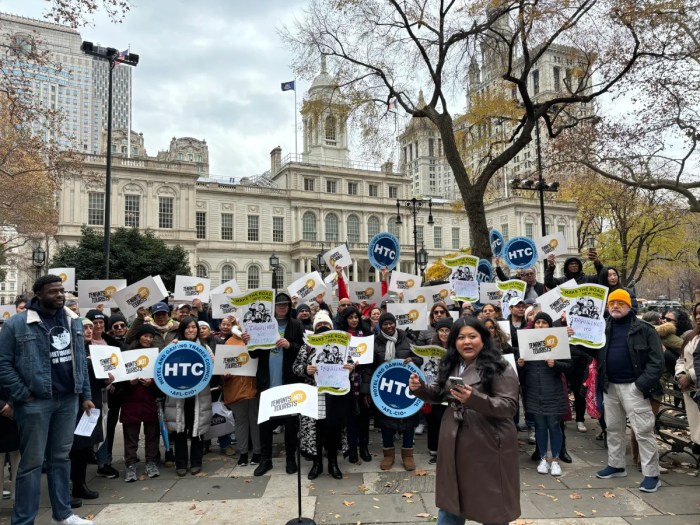POLITICAL NEWS Analysis
(AP) For those who agree with Mohandas Gandhi and Nelson Mandela that a society should be measured by how it treats its poorest, Gov. Andrew Cuomo’s much-praised “new New York” plan needs some work.
The Democrat is racking up political victories as a fiscal conservative and rave reviews by most New Yorkers for his $25 billion plan to lure employers, usher in the nation’s biggest convention center, expand casino gambling, and improve schools while making government smaller. The New York Times called last Tuesday’s (Jan. 17) $132.5 billion budget “smart ideas that the state needs,” while the headline for New York Post editorials wished: “Godspeed, Governor.”
“This is a pro-economic growth strategy based on fiscal discipline, real reform and the exciting area of entrepreneurial government to lead us to a new New York,” Cuomo belted out last Tuesday.
Most New Yorkers mired in 8 percent unemployment and years of overspending and hollow pledges to scrape the rust off the Empire State cheered in a kind of 1990s flashback, not caring much about the fine print.
But deeper in the flat $132.5 bil- lion budget that closed a $2 billion deficit, Cuomo also proposed to delay half of a modest increase in the basic welfare grant, now about $350 a month for a family of three. In June, the basic grant was scheduled to increase 10 percent. But the governor wants to split that over two years. The increase this year for a family living through a historic recession would be 50 cents a day.
Total savings to the state: $6 million.
“To say, ‘We’re going to take $6 million from the poorest of the poor,’ sort of riles us up,” said Mark Dunlea of Hunger Action Network of New York. Even the total increase, which would add $1 a day, “is totally inadequate. We’re still talking about keeping people well below the federal poverty level. And we’re talking about children.”
Nowhere in the governor’s rous- ing State of the State and budget addresses this month was a mention of raising the minimum wage, unchanged since 2004, before the recession hit the poor the hardest. New York, with its high costs, especially in cities that depend on the low-wage workers, trails 17 states, including Massachusetts, Connecticut, California and Wyoming.
“They can’t make ends meet,” Assembly Speaker Sheldon Silver said in an interview. “The need is clear.”
At just over $15,000 a year, a minimum wage worker is making less than a third of the typical wage of a New Yorker. The minimum wage in Connecticut and Nevada is $1 higher per hour than New York’s.
While the state Business Council and other groups warn raising the minimum wage would force employers already strained by recession to cut jobs, Silver disputes that and says it will fuel a sluggish economy. Even business legend Michael Bloomberg, New York City’s mayor, supports it.
“It’s an immediate boost to the economy,” Silver said. “It’s better than tax cuts.”
There are more areas of concern in Cuomo’s vision of a “new New York.” They include eliminating costof living adjustments for workers at nonprofit groups in health, foster care, mental health and adoption programs. Cuomo is calling for COLAs to be suspended until they are justified.
For corporations, loopholes will continue until a full review, although advocates for the poor have identified suspects for years.
“Our current corporate tax law has more holes than Swiss cheese,” said Ron Deutsch of New Yorkers for Fiscal Fairness.
Even in the biggest area of increase- school aid-the fine print of the budget is raising concern.
Cuomo proposes a four-percent increase in school aid, part of a deal struck a year ago with the Legislature to soften a cut back then. The proposed four-percent increase is worth $805 million for the state’s more than 700 school districts and three-quarters would help high-needs schools most. That has comforted schools after lean years.
Then Cuomo pulled $250 million of it out for his competitive grants to force classroom improvements and efficiencies. Most applauded Cuomo for using his only real tool-funding- to improve the massive bureaucracy. But that means millions won’t automatically go to the neediest districts.
“Students have a right to a quality education, not only a right to compete to potentially get one,” said Billy Easton of the Alliance of Quality Education, a school aid advocacy group of parents and teachers.
There are others: Funding would also be eliminated in the Neighborhood and Rural Preservation programs that bolster low-income areas, saving the state just $12 million.
And hundreds of thousands of families in the State University of New York and City University of New York face a second year of $300 increases in tuition.
“The budget says we haven’t quite penetrated Gov. Cuomo’s consciousness,” said Dunlea, of the statewide hunger group. He said he and other advocates will now band together to lean on the Legislature to restore funding working with the Occupy Wall Street progressive movement that riveted public and political attention it the fall.
“We will add our agenda onto their mission,” Dunlea said. “Now we have a center for all of us to work together.”




































